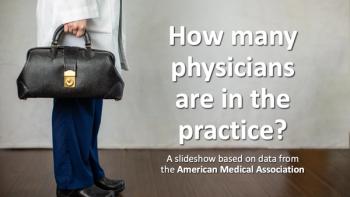
Case Study: Reducing Renal Progression With SGLT-2 Inhibitors
A case study for a patient who required additional SGLT-2 inhibitors to help reduce progression of renal disease is presented, and Drs Robert Busch, Dhiren Patel, and Muthiah Vadugananthan share their final thoughts on renal protective agents.
Dhiren Patel, PharmD, CECES, BC-ADM: Dr Busch, I’d love to hear a real-life example of 1 of your patients. We have a 78-year-old gentleman who has a long-standing history of diabetes, high blood pressure, and dyslipidemia. Could you walk us through how you approached this patient’s CKD [chronic kidney disease] and what you did for him?
Robert Busch, MD: This gentleman was referred to us. He had diabetes, hypertension, and hyperlipidemia. He was on a statin. His LDL was at goal. His triglycerides were not high, and he was on a maximal-dose RAS blocker with quinapril. Often, patients who are referred in are on metformin and DPP4. He was on sitagliptin-metformin combination. His GFR [glomerular filtration rate] was in the 50s mL/min, and he had urine microalbumin in the 200s mg/dL.
He had stage IIIA chronic kidney disease. Previously he was on a RAS blocker. It was recommended, “Don’t take an NSAID or a COX2. If you go to a hospital, ask not to get x-ray dye if you could avoid x-ray dye, and don’t do any nephrotoxic drugs. Don’t take any over-the-counter drugs other than Tylenol. No Aleve, Motrin, or Advil.” We go through that every visit with the patient. There wasn’t much more you could do until recently, seeing the SGLT2 data that are out now. His A1C [glycated hemoglobin] was low 7%. We could say, “He’s 78-years-old, so low 7% isn’t so bad,” but we wanted to do better.
The goal when any of us walks in the exam room is, “What can I do better than the time before?” We added dapagliflozin 10 mg after seeing the results of Dapa-CKD. We also upgraded his DPP4 to a GLP1 for the weight and cardiovascular [CV] benefits. Dulaglutide has the primary prevention indication. This gentleman didn’t have previously known ASCVD [atherosclerotic cardiovascular disease], or he probably has some clinical disease. Instead of being on sitagliptin-metformin, he’s on GLP1 and metformin and dapagliflozin. The dapagliflozin specifically benefits the glucose as well, although the higher the GFR, the more glycosuria you would have. As we teach our students, if the kidney doesn’t see it, the kidney doesn’t pee it. You have to filter glucose.
Dhiren Patel, PharmD, CECES, BC-ADM: I love it.
Robert Busch, MD: You’re giving the dapagliflozin. Even if the GFR were 30-something mL/min, you’re still giving the dapagliflozin to prevent worsening kidney disease, but there it wouldn’t benefit the sugar that much. We upgraded his DPP4 to GLP1, which has its glycemic benefit, and added the dapagliflozin for renal protection. Because we’re in the Northeast, instead of the Acela train to dialysis, hopefully we’re delaying that train to dialysis and we’re flattening the curve.
Dhiren Patel, PharmD, CECES, BC-ADM: That’s a really good point on the eGFR [estimated GFR]. I remind our trainees the same thing. It’s not like a light switch that’s working at 45 mL/min but not at 44 mL/min. There’s a rate of diminishing return. You also need to recognize that it’s not always being looked at from the glycemic lens. We have a QI [quality improvement] project going on from renal in which everyone is getting dose maxed out on an ACE or an ARB. They’re looking at it from some of the other pleiotropic effects. We also know they’re not dose-dependent CV benefits or renal benefits. That’s a great real-life use case regarding the most recent data from Dapa-CKD.
As we close out this segment, I’d love it if both of you could share some closing remarks. We talked a little about diabetes as well as patients who don’t have diabetes and what you see happening in the next few years as more options become available. Do you have any parting comments regarding cardiovascular disease, CV risk, or some of the renal implications we talked about? We’ll start with you, Dr Vaduganathan.
Muthiah Vaduganathan, MD, MPH: I have 2 comments. One is that I thought Dr Busch nicely framed that patients are acutely aware of their kidney function and especially their near-term risk of dialysis. That’s an event they ask about and want to avoid. Patient activation is a really important strategy to potentially overcome therapeutic inertia in these circumstances. Making patients aware that new strategies are available to delay the need for dialysis is an important message to the community.
The second is from a heart failure lens. SGLT2 inhibitors form 1 of 4 pillars of heart failure care. Uniquely, though, it’s 1 of the only, if not 1 of 2, therapies that actually slow kidney progression in heart failure. While earlier therapies like ACE inhibitors and ARBs in the context of patients with heart failure may have even accelerated kidney decline, in this case, SGLT2 inhibitors—for the first time—have been shown to definitively delay clinical events, including progression to dialysis. That’s another motivating feature and benefit seen even among high-risk patients with established heart failure.
Dhiren Patel, PharmD, CECES, BC-ADM: I absolutely agree. Those were some relevant points. When you have a patient who’s motivated, the possibilities are endless. We’ve all had those patients who come in and want something or that intrinsic motivation is a big piece. Dr Busch?
Robert Busch, MD: You almost have to think to yourself, “Why shouldn’t I give an SGLT2? Where’s your ACE or ARB? Where’s your statin? Where’s your SGLT2? Look at all the benefits. Prove to me you don’t need the SGLT2 just like the statin and the RAS blocker. If we get to that, we’ll do more benefit than harm. You’re not going to give it to someone who has 6 yeast infections and is on an antibiotic. You’re not going to sneak it into a man with BPH [benign prostatic hyperplasia] who’s urinating every hour and say, “Now you can urinate every half-hour.” But you could sneak it in and give it every other day in the beginning. Try to get it on board and be comfortable with the safety profile for those who haven’t used it. It’s a terrific drug and has all those benefits we talked about.
Dhiren Patel, PharmD, CECES, BC-ADM: Excellent. Thank you both for sharing this valuable information. We hope you found it very valuable in how you may think about implementing this in your practices. Thank you all for watching this Medical Economics® Around the Practice program.
Transcript edited for clarity.
Newsletter
Stay informed and empowered with Medical Economics enewsletter, delivering expert insights, financial strategies, practice management tips and technology trends — tailored for today’s physicians.











